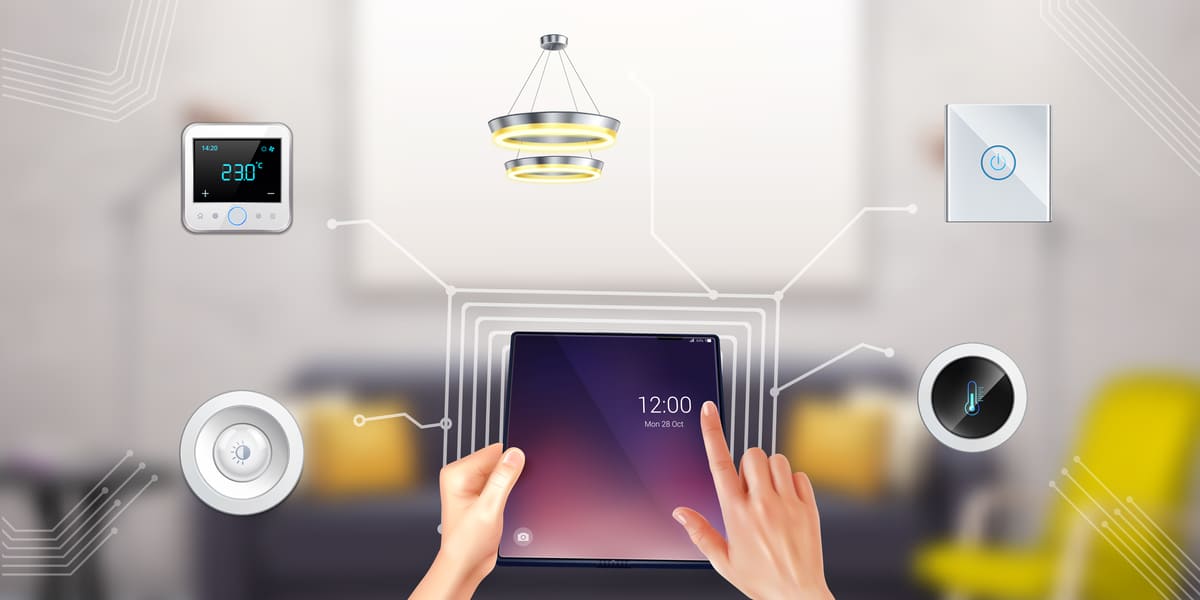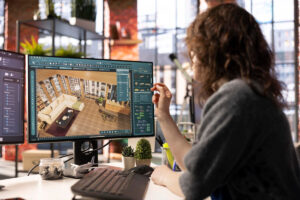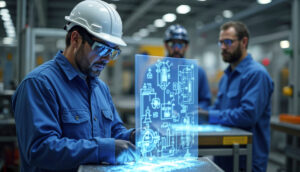Building Automation Systems (BAS) are becoming smarter and more efficient with the integration of IoT technologies. Modern IoT applications in building automation connect sensors, devices, and software to monitor and control a variety of building functions in real time. This convergence of BAS and the Internet of Things (IoT) is revolutionizing how we manage buildings of all types – from commercial offices and retail spaces to residential complexes and institutional facilities. The goal is to enhance operational efficiency, reduce energy consumption, improve occupant comfort, and strengthen safety and security. Given that buildings account for roughly 40% of global energy use, leveraging IoT-driven automation can have a substantial impact on sustainability and cost savings.
In this article, we explore five essential IoT applications in building automation systems. Each application is explained in clear, technical terms with practical examples. These applications are broadly applicable across different building types and demonstrate how IoT technologies are modernizing facility management in a didactic, easy-to-understand way.
Table of Contents
5 Essential IoT Applications in Building Automation Systems
Here are 5 Essential IoT Applications in Building Automation Systems you must know about in 2025:
1. Smart HVAC and Climate Control
Heating, Ventilation, and Air Conditioning (HVAC) systems are major energy consumers and critical for occupant comfort. IoT-enabled HVAC control is an essential building automation application that uses connected sensors and smart devices to optimize climate conditions. Smart HVAC systems can automatically adjust heating and cooling in response to real-time data such as temperature, humidity, air quality, and occupancy levels. For example, IoT sensors detect when a conference room is occupied and instruct the HVAC to deliver cooling only to that area, reducing needless conditioning in empty rooms. In a residential setting, a smart thermostat (an IoT device) might learn your schedule and adjust home temperatures for comfort before you arrive while conserving energy when you’re away.
Key capabilities of IoT-based HVAC automation include:
-
Adaptive Temperature Control: Smart thermostats and temperature sensors continuously monitor indoor climate and adjust HVAC settings to maintain desired temperatures with minimal energy use. For instance, if afternoon sun heats up one side of a building, IoT sensors can signal the system to cool that zone more aggressively while avoiding over-cooling shaded zones.
-
Occupancy-Based Ventilation: Motion detectors and CO₂ sensors identify occupied spaces and trigger ventilation or fresh air exchange only when needed. This ensures good air quality and comfort in occupied rooms without running fans at full speed in vacant areas.
-
Remote and Automated Management: Facilities managers can monitor and control HVAC systems remotely via cloud-connected BAS dashboards or mobile apps. HVAC schedules (e.g., lowering heating setpoints at night or on weekends) can be automated and fine-tuned easily from anywhere. This remote IoT application control enables faster response to issues and adjustments without requiring on-site staff.
Real-world example: In a large office building, IoT sensors measure temperature and humidity on each floor, while smart damper actuators adjust airflow to each zone. During working hours, conference rooms and open office areas are kept at comfortable temperatures. After hours, the system automatically goes into an energy-saving mode, allowing temperatures to drift within a broader range. If an unexpected meeting occurs late at night, a facility manager can remotely override the schedule via an app to ensure comfort.
This level of dynamic control can yield substantial energy savings – studies indicate that IoT-driven intelligent HVAC management can cut HVAC energy usage by about 20–25% by avoiding unnecessary heating or cooling. Given that HVAC can account for up to 40% of a building’s energy consumption, such savings are extremely impactful for both cost reduction and sustainability.
Suggested article to read: IoT in Insurance; 2024 Review

2. Smart Lighting Systems
Lighting is another core building system where IoT applications have become essential. Smart lighting systems use IoT-connected bulbs, luminaires, sensors, and controllers to automate and optimize a building’s lighting based on real-time conditions. Rather than relying on manual light switches or fixed timers, an IoT-based lighting control system can make intelligent decisions: for example, turning lights off when rooms are unoccupied or dimming artificial lighting when plenty of daylight is available.
How IoT enhances lighting control:
-
Occupancy Sensing: Motion detectors or occupancy sensors are placed in offices, hallways, and rooms to detect presence. The lighting system can automatically switch lights on when people enter a space and switch them off or dim them when the space is empty. In a mixed-use commercial building, this might mean corridor lights are kept low until someone approaches, and then they brighten – saving energy during idle periods.
-
Daylight Harvesting: Light sensors measure natural light levels coming through windows or skylights. IoT lighting controllers then dim or brighten indoor fixtures to maintain consistent illumination with minimal waste. For example, on a sunny day, perimeter office lights near windows can dim down, since sunlight is providing adequate lighting. This balance maintains comfort for occupants while reducing electricity usage.
-
Central Scheduling and Remote Control: Through an IoT-connected lighting management platform, building operators can set schedules (e.g., lights off at midnight, or only security lighting overnight) and make on-the-fly adjustments remotely. If an office floor is unoccupied due to a holiday, the manager can ensure lights stay off via a smartphone or laptop. Manual overrides and scenes (preset lighting configurations) can also be programmed and triggered remotely.
Real-world example: In a smart university campus building, hallway and classroom lights are managed by an IoT application lighting system. During daytime, corridor lights automatically dim when sunlight floods the halls. In classrooms, lights turn off shortly after classes end if no motion is detected. Cleaning staff have override controls to turn lights on after hours as needed, but the system returns to auto-mode afterwards. This IoT-driven approach provides both convenience and significant energy savings.
A building lighting control system that uses smart bulbs and occupancy sensors can drastically cut power usage – often reducing lighting energy consumption by 30% or more compared to always-on conventional lighting. Occupants benefit as well, since areas are well-lit when in use and unnecessary lighting (which can cause glare or discomfort) is minimized when spaces are empty.
3. Security and Access Control
Building security has been transformed by IoT applications, making security and access control systems more intelligent and responsive. Traditional security systems (locks, CCTV cameras, alarm sensors) operated in silos or required on-site monitoring. In contrast, IoT-enabled security integrates these devices into the building’s network, allowing for centralized monitoring, remote control, and data sharing between security components. This application is crucial across commercial offices, apartments, and institutional buildings to protect assets and ensure occupant safety.
IoT-based security and access control features:
-
Connected Access Systems: Smart locks, card readers, and keyless entry systems (often using RFID badges or smartphone credentials) are IoT devices that communicate with a central platform. Facility managers can remotely lock or unlock doors, change permissions, and receive alerts when unauthorized access is attempted. For instance, an office manager might grant a contractor temporary building access via an IoT access control app, rather than issuing a physical key.
-
Integrated Surveillance and Sensors: IoT technology links together security cameras, motion detectors, glass-break sensors, and alarm systems on a single network. Rather than each camera or alarm being isolated, all feed into a unified dashboard. This integration makes it easier to monitor entry points and detect suspicious activity in real time. If motion is detected in a restricted area after hours, the system can automatically notify security personnel and stream the relevant camera footage to their mobile device.
-
Data-Driven Access Management: Because IoT security devices are networked, they can log detailed data on entries and exits. Building management can analyze this data for patterns – for example, tracking which times certain doors see heavy use – and optimize security staffing or policies accordingly. Additionally, integration with occupant directories or tenant databases enables features like smart elevators that take someone to the correct floor based on their access credentials, or visitor management systems that send digital passes to smartphones.
Real-world example: A modern apartment building uses IoT application access control for its residents. Tenants unlock the main entrance and their units via a secure smartphone app or key fob, with a cloud-based system logging each entry. Security cameras in lobbies and hallways are IP-connected and accessible to the building security team remotely. If a camera detects motion at a fire exit door, an alert is sent and the camera feed pops up for the guard to review, even if they are offsite. Meanwhile, building management can easily revoke or grant access permissions digitally (for new tenants or maintenance personnel).
The IoT integration of locks, cameras, and sensors means the entire security apparatus functions as one coordinated system. This not only improves safety but also reduces costs – for example, fewer on-site security staff are needed when remote monitoring and automated alerts can cover routine surveillance. Overall, IoT-enhanced security provides peace of mind through stronger control over who enters the building and how the premises are monitored at all times.

4. Energy Monitoring and Management
IoT applications in building automation go beyond controlling devices in real time – they also include advanced energy monitoring and management systems. These solutions use IoT application sensors, smart meters, and analytics software to track how a building consumes resources (electricity, gas, sometimes water) in granular detail. By collecting continuous data from various systems and equipment, IoT-based energy management platforms help facility operators identify inefficiencies, optimize usage, and make informed decisions to reduce waste.
Key aspects of IoT energy management:
-
Smart Meters and Submetering: IoT-enabled energy meters can be installed at different levels – for the whole building, for each floor, or even for individual large equipment like chillers or server rooms. These devices measure real-time power consumption and share data to a central cloud platform. By analyzing this data, managers can perform energy benchmarking between different areas or against industry standards. For example, if one tenant’s floor consistently uses more electricity than others of similar size, it could indicate inefficient equipment or behavior that the building management can address.
-
Real-Time Alerts and Insights: The IoT energy management software can be configured to alert operators when unusual consumption patterns occur. If a particular motor or HVAC unit starts drawing excessive power (possibly due to a fault), the system flags it. The platform can also provide insights and recommendations – for instance, suggesting adjustments to HVAC schedules or identifying lights that were left on outside of operating hours. These data-driven insights help integrate best energy practices into daily operations.
-
Integration with Building Controls: Energy management isn’t just passive monitoring; it often ties back into active control. IoT platforms can automatically adjust systems to save energy – such as slightly dimming lights during peak demand hours or pre-cooling a building when electricity rates are lower. In advanced setups, a building’s IoT system may interact with the smart grid, responding to demand response events (e.g., temporarily reducing HVAC power use when the grid is strained). Additionally, IoT-managed renewable energy sources like rooftop solar panels can be optimized to support the building’s power needs (and even feed excess energy back to the grid).
Real-world example: A mixed-use commercial complex deploys an IoT energy management platform to oversee electricity usage. Smart meters on each major electrical panel report consumption every minute. The system dashboard highlights that Building A’s energy use spikes at noon, coinciding with all HVAC units running and elevator use peaking. By analyzing IoT application data, the facility team staggers the elevator schedules and pre-cools the building slightly earlier in the morning, flattening the noon peak. The platform also benchmarks energy performance and shows that one of the office suites has unusually high after-hours power usage.
Upon investigation, they find an older HVAC unit running inefficiently – a problem that might have gone unnoticed without IoT monitoring. After servicing the unit, the suite’s energy consumption returns to normal, saving costs. This proactive approach demonstrates how IoT-based energy monitoring provides actionable intelligence. In essence, such systems turn raw sensor data into recommendations for better energy efficiency, helping eliminate waste and lower operating expenses. Over time, the building can achieve higher energy efficiency ratings and even earn sustainability certifications by continuously improving via IoT application insights.

5. Predictive Maintenance and Asset Management
Maintaining building equipment – HVAC plants, pumps, elevators, lighting fixtures, and other machinery – is traditionally a reactive or schedule-based process. IoT applications are changing that through predictive maintenance, which is an essential use case in modern building automation. By outfitting critical assets with IoT sensors and monitoring their performance data, facility managers can predict when components are likely to fail or require service, and act before a breakdown occurs. This approach maximizes uptime, extends the lifespan of equipment, and reduces maintenance costs by preventing major failures.
How IoT enables predictive maintenance:
-
Continuous Equipment Monitoring: IoT sensors attached to equipment measure parameters like vibration, temperature, pressure, and current draw. For instance, a vibration sensor on an air handling unit’s motor can detect subtle increases in vibration over time, which may indicate a developing mechanical issue (such as a bearing wearing out). These sensor readings are sent to a central system continuously. Abnormal patterns or thresholds trigger alerts for maintenance personnel. As an example, if a pump’s outlet pressure drops below a certain level while the motor current spikes, the IoT system might detect a probable clog or mechanical degradation.
-
Data Analysis and Failure Prediction: Advanced analytics and AI can be applied to the IoT data stream to predict failures. The system might compare current performance against historical baselines or known failure signatures. If the data suggests an impending issue – say, a cooling tower fan is trending hotter and drawing more power than usual – the software will recommend a maintenance check. Building operators thus receive a heads-up to service equipment before a malfunction occurs. In many cases, this prevents disruptive outages (like an HVAC breakdown on a hot day or an elevator stalling) that would inconvenience occupants.
-
Optimized Maintenance Scheduling: With IoT application asset management, maintenance can be scheduled based on actual equipment condition and usage rather than just fixed intervals. Sensors tracking run-time hours or cycles can inform when servicing is truly needed. For example, an IoT-monitored backup generator might report that it has run 100 hours since last service, prompting maintenance exactly when due. This ensures critical systems are maintained just in time, improving reliability while avoiding unnecessary routine checks on still-healthy equipment.
Real-world example: Consider a large hospital that uses IoT predictive maintenance for its building systems. Critical equipment like chillers, emergency generators, and air handling units are fitted with sensor packs. One day, the IoT dashboard flags that Chiller #2 has an elevated vibration reading and a slight drop in cooling output. The facility team inspects the chiller and finds a compressor bearing starting to fail; they replace it during a scheduled downtime that night. By catching it early, the hospital prevents a costly emergency repair and avoids discomfort to patients from a cooling outage.
In another case, IoT energy monitors on an elevator motor detect it drawing more current than normal on certain trips, suggesting increased friction. A technician is dispatched and discovers an issue with the elevator’s guide rails, which is fixed proactively. These scenarios illustrate how IoT-based predictive maintenance tools can detect subtle signs of trouble and prevent breakdowns and downtime. Over a year, the hospital reports fewer unexpected equipment failures and estimates significant savings in repair costs. The maintenance staff can also work more efficiently, focusing on equipment that actually needs attention as indicated by sensor data, rather than spending equal time on all devices regardless of condition.
FAQs
How do IoT applications in building automation systems improve energy efficiency?
- Answer: IoT applications improve energy efficiency in buildings by optimizing the operation of key systems like HVAC and lighting. Smart HVAC controllers adjust heating and cooling based on occupancy and ambient conditions, avoiding energy waste from running equipment when not needed. IoT-connected lighting automatically dims or switches off lights in unoccupied areas and takes advantage of natural daylight, which cuts down electricity usage. Additionally, IoT energy management platforms continuously monitor consumption and provide analytics – this helps facility managers identify inefficiencies (such as equipment using excessive power) and adjust settings or schedules for better efficiency.
What are common IoT devices used in building automation systems?
- Answer: A variety of IoT applications are employed in building automation to sense conditions and enact controls. Common IoT sensors include temperature sensors, humidity sensors, occupancy/motion detectors, light level sensors, and air quality sensors (measuring CO₂ or pollutants). These feed data to the automation system. On the control side, devices like smart thermostats and connected HVAC dampers adjust heating/cooling output, while smart lighting fixtures or controllers adjust brightness or turn lights on/off. In security systems, smart locks and badge readers control access, and IP security cameras provide surveillance feeds.
Which building operations benefit the most from IoT technology integration?
- Answer: The building operations that see the most benefit from IoT integration are those related to energy management, climate control, and security/maintenance. HVAC operations greatly benefit because IoT allows precise control of heating and cooling based on real-time need, improving comfort while saving energy. Lighting operations also gain efficiency and flexibility through IoT sensors and scheduling. Security and access control operations benefit by unifying cameras, locks, and alarms into one IoT-managed platform, improving response times and oversight.
Is it true that IoT-based building automation can reduce operating costs significantly?
- Answer: Yes, implementing IoT in building automation can significantly reduce operating costs over time. The cost savings primarily come from improved energy efficiency and preventive maintenance. By using IoT to trim unnecessary energy use (for example, not overcooling or lighting empty spaces), buildings consume less power – this directly lowers utility expenses. IoT-based analytics often reveal opportunities to optimize schedules or equipment settings that human operators might miss, yielding further savings. Another cost reduction comes from predictive maintenance: catching a failing component early via IoT sensors is much cheaper than dealing with a major breakdown later. This reduces emergency repair costs and extends the lifespan of expensive equipment.
Conclusion
The integration of IoT application with building automation systems is reshaping how modern buildings are managed. In this article, we examined five essential IoT applications in building automation – smart HVAC control, intelligent lighting, security and access management, energy monitoring, and predictive maintenance. Each of these applications contributes to a more efficient, safe, and responsive building. By leveraging networks of sensors and smart devices, facilities can improve energy efficiency, enhance security, enable remote management, and reduce operational costs
Importantly, these IoT solutions are scalable across building types: from a single-family smart home using a thermostat and smart locks, to a high-rise office with thousands of sensors integrated into a centralized building automation system (BAS). The examples discussed show real-world benefits such as lower energy bills, greater occupant comfort, proactive equipment upkeep, and streamlined operations. As IoT technology continues to advance, building automation systems will become even more interconnected and intelligent, unlocking new possibilities for optimizing the spaces where we live and work.
Resources:
-
Zenatix (Schneider Electric). Gupta, M. (2023). The Role of IoT in Building Automation Systems.
-
Mid-Atlantic Controls. (2024). 8 Smart Buildings IoT Applications for Property Management Groups.
-
Digi International. (2024). IoT Applications for Smart Buildings: Use Cases and Top Benefits.
-
Zenatix (Schneider Electric). Gupta, M. (2022). How IoT is Making HVAC Smart and Energy-Efficient?
-
Smart Building Magazine. (2023). Energy Saving in Smart Buildings.
For all the pictures: Freepik
Suggested article for reading:
Top 7 Trends in Architecture Embracing Sustainability in 2025
Top 5 Trends in Security Automation for Smart Buildings
Key Strategies for Risk Management in Construction; 2025
Top 12 Must-See Architectural Projects in Milan
AI-designed Architecture Projects that Redefine Design in 2025
Top 15 Urban Design Tools for 2025
Future of Construction Management: 10 Trends you Need to Know
How Virtual Construction Assistants Improve Project Management; 2025




